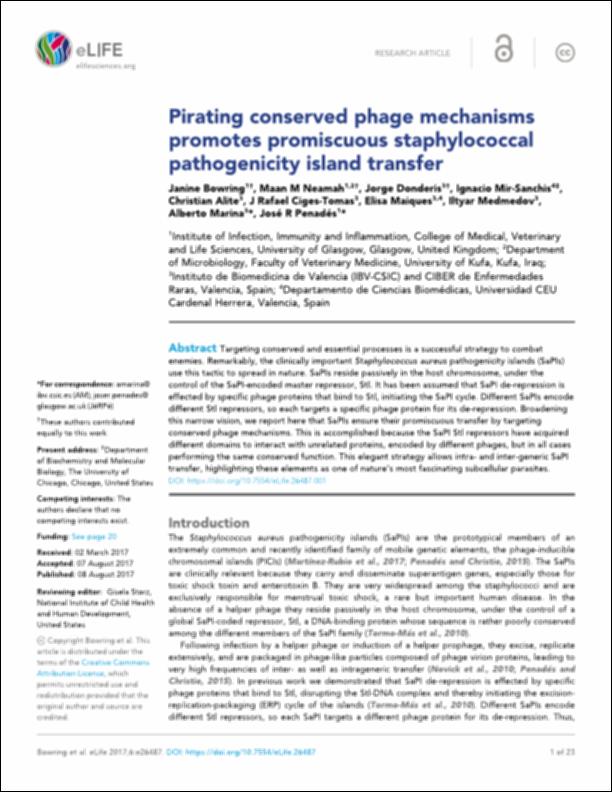Please use this identifier to cite or link to this item:
http://hdl.handle.net/10637/10613Pirating conserved phage mechanisms promotes promiscuous staphylococcal pathogenicity island transfer
| Title: | Pirating conserved phage mechanisms promotes promiscuous staphylococcal pathogenicity island transfer |
| Authors : | Bowring, Janine Neamah, Maan M. Donderis, Jorge Mir Sanchis, Ignacio Alite, Christian Ciges Tomás, J. Rafael Maiques Fernández, Elisa Mehmedov, Iltyar Marina, Alberto Penadés Casanova, José Rafael |
| Keywords: | Bacteriología médica.; Medical bacteriology.; Enfermedades infecciosas.; Staphylococcus.; Estafilococos.; Microbiología médica.; Medical microbiology.; Communicable diseases. |
| Publisher: | eLife Sciences Publications. |
| Citation: | Bowring, J., Neamah, MM., Donderis, J., Mir-Sanchis, I., Alite, C., Ciges-Tomas, JR. et al. (2017). Pirating conserved phage mechanisms promotes promiscuous staphylococcal pathogenicity island transfer. eLife, vol. 6, art. e26487 (aug. 2017). DOI: https://doi.org/10.7554/eLife.26487.001 |
| Abstract: | Targeting conserved and essential processes is a successful strategy to combat enemies. Remarkably, the clinically important Staphylococcus aureus pathogenicity islands (SaPIs) use this tactic to spread in nature. SaPIs reside passively in the host chromosome, under the control of the SaPI-encoded master repressor, Stl. It has been assumed that SaPI de-repression is effected by specific phage proteins that bind to Stl, initiating the SaPI cycle. Different SaPIs encode different Stl repressors, so each targets a specific phage protein for its de-repression. Broadening this narrow vision, we report here that SaPIs ensure their promiscuous transfer by targeting conserved phage mechanisms. This is accomplished because the SaPI Stl repressors have acquired different domains to interact with unrelated proteins, encoded by different phages, but in all cases performing the same conserved function. This elegant strategy allows intra- and inter-generic SaPI transfer, highlighting these elements as one of nature’s most fascinating subcellular parasites. |
| Description: | Este artículo se encuentra disponible en la página web de la revista en la siguiente URL: https://elifesciences.org/articles/26487 |
| URI: | http://hdl.handle.net/10637/10613 |
| Rights : | http://creativecommons.org/licenses/by/4.0/deed.es |
| ISSN: | 2050-084X (Electrónico) |
| Issue Date: | 1-Aug-2017 |
| Center : | Universidad Cardenal Herrera-CEU |
| Appears in Collections: | Dpto. Ciencias Biomédicas |
Items in DSpace are protected by copyright, with all rights reserved, unless otherwise indicated.


